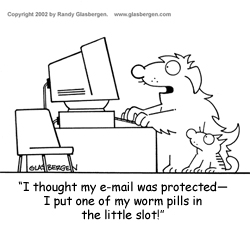October 2004
Volume 8, Issue 1
Inside this Issue...
Social Science Computing Laboratory
Faculty of Social Science
Room 1228, Social Science Centre
The University of Western Ontario
London, Ontario, Canada, N6A 5C2
E-mail ssts@uwo.ca
Web: www.ssc.uwo.ca/ssnds
Phone: 519 661-2152
Managing Editor: Mary Van de Ven
SSC Network Update
Viruses, Adware and Spyware
Heather Stevens
When we speak of computer viruses today it may include viruses, worms, trojans, bots, adware or spyware. These malware are not all viruses, but they do disrupt our work and damage our computers.
How do we avoid getting malware on our computers?
-
 Make sure your computer has Trend Officescan or
Make sure your computer has Trend Officescan or
PC-cillin installed and up-to-date. This will protect you from known viruses. See the Trend Officescan Current Versions network notice. - Make sure your Windows Updates are current. Microsoft identifies security flaws in its Windows software and releases updates to correct these flaws. Virus writers exploit these weaknesses and gamble that most users will not apply their Windows Updates. Windows Updates for Windows 2000/XP in the Social Science Centre will now be automatically downloaded and installed. Windows 98/Me users and home users will have to run Windows Update from the Start menu or from the Windows Update icon in the task bar on a regular basis.
- Be careful where you surf. Some browser and search engine hijackers arrive by drive-by download. This happens when you are surfing the wrong web sites and you are missing a critical update.
- Read the fine print when installing free software from the Internet. The authors of this software may make a deal to distribute adware/spyware with their free software to supplement their income. Usually, the inclusion of this malware is described in the license agreement. Read the license agreement and if you see that other software will be installed with the software you are installing, cancel the installation.
- Exercise caution when downloading files from the Internet. Ensure that the source is a legitimate and reputable one. Verify that an anti-virus program checks the files on the download site. If you are uncertain, don't download the file at all.
- Never open an e-mail attachment from someone you donít know.
- Check with the sender before opening an unexpected attachment.
- Always err on the side of caution and do not open, download, or execute any suspicious files or e-mail attachments.
Virus False Alarms
 Recently,
people have been receiving e-mail messages that say a virus was detected in
a message they sent. The virus identified in the e-mail usually turns out to
be the Netsky virus. With this, and other similar viruses, usually
another computer is infected and is spreading the virus via e-mail forging
your address as the sending address. You donít need to worry about these
messages.
Recently,
people have been receiving e-mail messages that say a virus was detected in
a message they sent. The virus identified in the e-mail usually turns out to
be the Netsky virus. With this, and other similar viruses, usually
another computer is infected and is spreading the virus via e-mail forging
your address as the sending address. You donít need to worry about these
messages.
Do You Have Adware or Spyware?
If you get a lot of pop-ups when you are surfing the Internet, or Trend detects a virus with the ADW prefix, then the chances are that you already have adware or spyware. To rid your computer of this malware, we recommend using two programs: Ad-Aware and Spybot Search & Destroy. These can be installed as follows:
Start > All Programs > SSC Network > Add-Remove Programs > Add New Programs > Ad-Aware 6.0 and Spybot Search & Destroy 1.3
After installing the programs, run one first and then reboot your system before running the other. Before you run each program, be sure to check for and apply all updates. In our experience, it is safe to choose to clean all adware and spyware occurrences found by the programs.